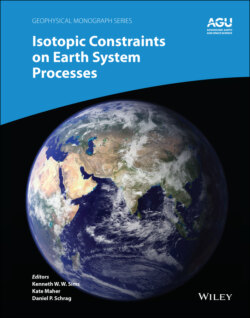Читать книгу Isotopic Constraints on Earth System Processes - Группа авторов - Страница 61
2.5.3. Comparison to Previous Studies
ОглавлениеIt was shown previously that β factors correlate with the diffusivity of the cation normalized by that of Si (or SiO2) (Fig. 2.8). Since Si is strongly bound in multi‐atom complexes with O (as well as Al and other Si atoms), it diffuses more slowly than other elements, and hence the ratio Di/DSi is generally greater than unity. For elements present in major quantities, the ratio Di/DSi is typically close to unity because of the cooperative motion that is required to yield a net flux of counter‐diffusing major elements. The regime where Di/DSi is high tends to occur in more silica‐rich liquids and with decreasing temperature (Dingwell, 1990).
Figure 2.8 β factors from this study (points with an asterisk) compared to literature values. The quantity /DSi is used as a proxy for extent to which a diffusing cation is coupled to the melt matrix. The Ca β factor is offset from the overall trend, but this may be because is overestimated. The β factor for K is the largest value yet reported for diffusion in silicate liquids.
The ratio /DSi is inferred to be about 20, and the β factor for Ca is offset from the overall trend. The ratio /DSi is inferred to be about 35 and the β factor for K is the highest value yet determined for diffusion in silicate liquids. Despite K2O being present in major quantities, it behaves like a trace element insofar as its diffusion is kinetically decoupled from the motion of the slower‐moving aluminosilicate structures (cf. Dingwell, 1990). The high β factor suggests that large diffusive isotope effects can arise in high‐T environments and our results should aid in the search for, and interpretation of, potentially large kinetic K isotope effects in nature.
